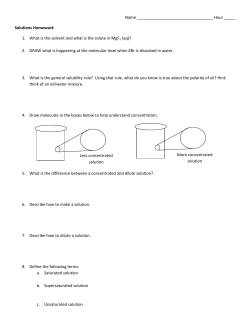
Things you must KNOW
Things you must KNOW You must KNOW your polyatomics You must KNOW how to write a balanced formula You have to be able to balance a chemical equation You need to know how to convert from grams to moles and moles to grams. You need to be able to calculate molar mass What to expect in this chapter You will be converting grams to moles of one compound, then using the mole ratio (balanced equation) go to moles of another compound and then from moles to grams in the new compound. You will learn how to identify a limiting reactant, and how to calculate percent yield. What does the standard say and what should I be able to do? Sc2d. Identify and solve different types of stoichiometry problems, specifically relating moles to moles Given the number of moles of a reactant or product solve for the moles of another reactant or product. What is Stoichiometry? Stoichiometry: the study of quantitative relationships between amounts of reactants used and products formed by a chemical reaction. Based on the Law of Conservation of Mass (mass reactants = mass products) To prove Law of Conservation of Mass 1. Start with a balanced equation 2. Coefficient indicates the #molecules/formula units and # of moles 3. Change moles to mass 4. Add up mass reactants and mass of products They should equal C3H8(g) + 5 O2(g) 3 CO2(g) + 4 H2O(g) What is Stoichiometry? : continued Can use balanced chemical equation to get mole ratios 2 Al + 3 Br2 2 AlBr3 2 mol Al 3 mol Br2 2 mol Al 2 mol AlBr3 3 mol Br2 2 mol AlBr3 Find all the possible mole ratios for: KClO3(s) KCl(s) + O2(g) Stoichiometric Calculations Use relationships to determine the amount of product formed or reactant needed. Moles to moles Moles known x mol unknown = mol unknown mol known from problem ratio from balanced equation Practice problem How many moles of carbon dioxide are produced when 10.0 moles propane (C3H8) are burned in excess oxygen? 1.Write & balance the equation Practice problem How many moles of carbon dioxide are produced when 10.0 moles propane (C3H8) are burned in excess oxygen? 1. Write & balance the equation C3H8 + 5 O2 3 CO2 + 4 H2O 2. Find the mole ratio between propane and carbon dioxide: Practice problem How many moles of carbon dioxide are produced when 10.0 moles propane (C3H8) are burned in excess oxygen? 1. Write & balance the equation C3H8 + 5 O2 3 CO2 + 4 H2O 2. Find the mole ratio between propane and carbon dioxide: 1 mol C3H8 : 3 mol CO2 3. Multiply ratio by known amount from problem Practice problem How many moles of carbon dioxide are produced when 10.0 moles propane (C3H8) are burned in excess oxygen? 1. Write & balance the equation C3H8 + 5 O2 3 CO2 + 4 H2O 2. Find the mole ratio between propane and carbon dioxide: 1 mol C3H8 : 3 mol CO2 3. Multiply ratio by known amount from problem 10 mol C3H8 x 3 mol CO2 = 30 mol CO2 1 mol C3H8 Standard Check Given the number of moles of a reactant or product can you solve for the moles of another reactant or product? Second part of standard Sc2d. Identify and solve different types of stoichiometry problems, specifically relating mass to moles and mass to mass. Stoichiometric Calculations : continued Moles to mass Determine the mass of sodium needed when sodium reacts with 1.25 moles of chlorine gas to form sodium chloride 1. Write & balance the equation 2. Find the mole ratio between sodium and chlorine: 3. Multiply ratio by known amount from problem 4. Change moles to grams Stoichiometric Calculations : continued Moles to mass Determine the mass of sodium needed when sodium reacts with 1.25 moles of chlorine gas to form sodium chloride 1. Write & balance the equation 2 Na + Cl2 2 NaCl 2. Find the mole ratio between sodium and chlorine: 2 mol Na: 1 mol Cl2 3. Multiply ratio by known amount from problem 1.25 mol Cl2 x 2 mol Na = 2.50 mol Na 1 mol Cl2 4. Change moles to grams 2.50 mol Na x 22.99 g Na = 57.48 g Na 1 mol Na Stoichiometric Calculations : continued Mass to mass 25.0 g ammonium nitrate produces dinitrogen monoxide and water when it decomposes. Find the mass of water produced. 1. Start with a balanced equation 2. Change grams to moles 3. Find the mole ratio 4. Multiply ratio by known amount from problem 5. Change moles to grams Stoichiometric Calculations : continued Mass to mass 25.0 g NH4NO3 produces N2O and H2O when it decomposes. Find the mass of water produced. 1. Start with a balanced equation NH4NO3 N2O + 2 H2O 2. Change grams to moles 25.0g NH4NO3 x 1 mol NH4NO3 = 0.312 mol NH4NO3 80.04g NH4NO3 3. Find the mole ratio : 1 mol NH4NO3 : 2 mol H2O 4. Multiply ratio by known amount from problem 0.312 mol NH4NO3 x 2 mol H2O = 0.624 mol H2O 1 mol NH4NO3 5. Change moles to grams 0.624 mol H2O x 18.02g H2O = 11.2 g H2O 1 mol H2O Standard Check Can you identify and solve different types of stoichiometry problems, specifically relating: mass to moles and mass to mass. Third part of standard Sc2e. Demonstrate the conceptual principle of limiting reactants. What should you be able to do: Work the problem and solve for the amount of product possible Use that info to pick out the limiting reactant Use that info to pick out the excess reactant Decide how much product is theoretically made Limiting Reactants Limiting reactant: the reactant that runs out 1st Excess reactant: the reactant that is left over To solve limiting reactant problems: 1. Work the problem using both reactants and solve the number of moles produced of the same product The one that produces the least amount of moles is the limiting reactant Standard Check Can you solve mole to mole conversions? Can you solve mass to mole conversions? Can you solve mass to mass conversions? Can you solve for theoretical yield and identify the limiting and excess reactant? Standard SCSh5. Students will demonstrate the computation and estimation skills necessary for analyzing data and developing reasonable scientific explanations. You will calculate percent yield as a way to analyze lab data and pinpoint reasons for discrepancies. Percent Yield Theoretical yield is the maximum amount of product that can be produced (determined through stoichiometric calculations) Actual yield is the amount produced in lab/from experiment Percent yield is the ratio of actual to theoretical expressed as a percent. % yield = actual yield x 100 theoretical yield Why dont we have 100%? Reasons for a decrease in percent yield Loss of products or reactants (spill, stick to side of containers) Reaction doesn’t go 100% Not all reactants react Impure reactants Dirty containers Percent Yield continued CH4 + 2 O2 CO2 + 2 H2O Determine the % yield if 10.0 grams methane burned to produce 19.5 g water. 1. Use stoichiometric calculations to determine theoretical yield of water produced from 10.0 g methane. 2. Using 19.5 g H2O as the actual yield, solve for % yield. Standard Check Can you solve mole to mole conversions? Can you solve mass to mole conversions? Can you solve mass to mass conversions? Can you solve for theoretical yield and identify the limiting and excess reactant? Can you solve for percent yield? Can you give reasons why the percent yield will not be 100%?
© Copyright 2025











